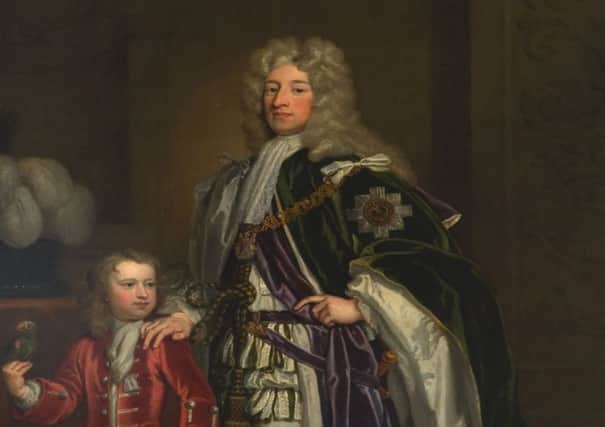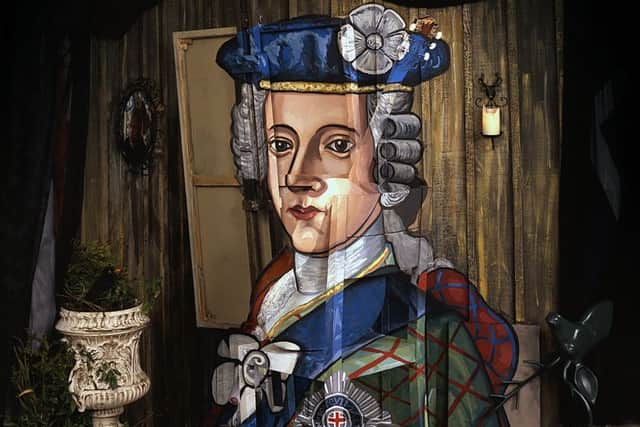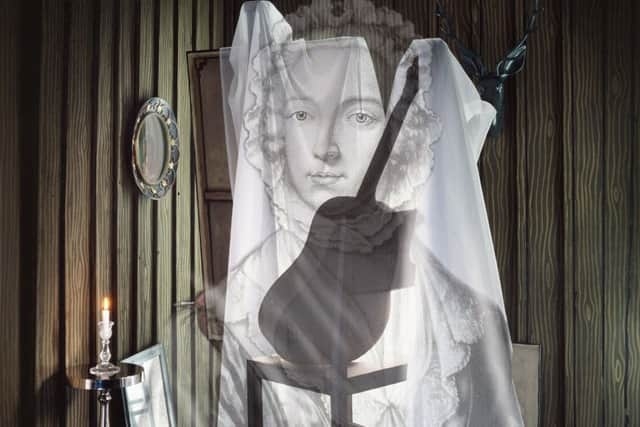The Jacobite art that faces up to the past


From the deposition of James VII and II in 1688 to the death in 1766 of his son, James III and VIII, the Old Pretender, Scotland and England had alternative kings. Their supporters were the Jacobites. Rallying them to his flag, the Young Pretender, Charles Edward Stuart, son of James III and VIII, flared like a meteor across the skies in 1745 but crashed to earth at Culloden in 1746. Although paradoxically it gave it new glamour, this was really the end of the Jacobite cause. Charles Edward himself was never recognised as king, but died in 1788, disappointed and in near obscurity. A medal in the SNPG’s rich Jacobite collection commemorates the hopeless claim of his younger brother, Cardinal Henry Benedict, to be his heir in turn as Henry IX. The last in a royal line stretching back 400 years, he died in 1807. Neverthheless the Jacobites were not forgotten. On the contrary, by historical symbiosis, their lost cause merged with nostalgia for Scotland’s lost nationhood and they have remained topical to this day.
Calum Colvin: Jacobites By Name | Rating: ****
Rise & Fall: The Earl of Mar and the 1715 Jacobite Rising | Rating: ****


Scottish National Portrait Gallery, Edinburgh
Advertisement
Hide AdThe Scottish National Portrait Gallery has now invited Calum Colvin to contribute a commentary to its Jacobite collection. Artists’ “responses” to historical works are generally lamentable. Not so with Colvin. He works by creating assemblages and then photographing them to make a single image and in his Ossian series, exhibited at the SNPG some years ago, he provided a subtle analysis of Scottish identity and the myths from which it is constructed: voices of the past, distorted as Chinese whispers as they echo faintly down the generations. So the Jacobites are the perfect subject for his art of allusion. Packing past and present in a single image, it illuminates both. The Stuarts were good-looking and much more glamorous than the dumpy Hanoverians. They were also more visually astute, but both sides used imagery as propaganda and in it, whether for or against, Charles Edward was usually clad in tartan. Thus, as the great lost cause of the Stuarts became identified with Scotland’s lost independence, the Prince’s tartan and his flight through the Highland landscape have provided the default imagery of Scottish identity and this is Colvin’s theme. A full-size replica of the Stuart tomb in St Peter’s stands in the Gallery entrance hall. Designed by Canova, George III contributed to the cost of the original, grateful, no doubt, to see the end of the Royal line of Stuarts, though, defiant even from the grave, the Old Pretender is twice named as James III on the tomb. Colvin has added a hologram to the tomb’s marble door so that it shimmers elusively between open and closed. Glimpsed inside, details of historic portraits, ghosts in the tomb, shift and dissolve. They appear to be slides on a screen. Their source is a projector on a stand, a motif that links several works here. Like the shadow play in Plato’s cave, it suggests that much that we take for reality is no more than a projection of the imagination, a story made up to explain the world. Thus Colvin deconstructs, not only the Stuart story, but also its persistent echoes in the present.
A model’s seat on a wooden dais, a stand-in throne, is also a frequent motif. In a portrait of James III and VIII, Mister Misfortune as he was called, his picture dissolves into a chair toppling off a step-ladder. If it is the ladder of ambition, the chair is made of glass, fragile hope of an elusive throne. To take its place among the historic portraits, this picture is hung in a gold frame. A portrait of Charles Edward in tartan is among several others framed this way. He wears the order of the Garter, but his face is little more than a cypher. A canvas on an easel and painting paraphernalia behind him suggest he is a construct like an art work. Antlers on the wall invoke the kitsch into which this imagined history sinks so easily. The whole decline and fall of the Jacobite cause is also presented in four contiguous images. They start with the handsome prince and end with a Hanoverian charger trampling on his hopes, but in the foreground the inscription on a rusty sword reads, “Prosperity to Scotland and No to the Union.”
One group of works enlarges on contemporary propaganda engravings exhibited alongside. On paper, they are hidden behind doors to keep them from the light, adding a frisson of the clandestine Jacobite cause. In Lochaber No More I, Colvin incorporates a portrait of the young Prince Charles Edward shortly after his escape from Scotland. Still a warrior, he is in armour, but in Colvin’s version his image dissolves among dust sheets and the debris of his disappointed hopes. A Scottie dog, a piece of Scottish kitsch, sits in front of him and an old gramophone plays the lament that, it is said, brought the Prince to tears in later life. Other Jacobites are remembered here too. An engraving shows the ghastly scene of the execution of the Jacobite lords. Among them, dressed in tartan, Lord Balmerino went bravely to his death. Colvin shows him with a tartan shopping trolley and one of those awful tartan tammies with a ginger fringe beside him. Modern tartan has usurped his dignity. The projector stand has here been replaced by an ironing board. Enigmatically, Man Ray’s Surrealist spiked iron, The Gift, sits on it. At one point in his escape the Prince dressed as a woman. His picture in drag published by his enemies should have been a propaganda coup, but in a particularly lovely image, Colvin suggests it backfired. His glamour transcended gender.


The last in this series mirrors the first, but the half-seen portrait is now of the old and disappointed prince among the ruins of his hopes. The two portraits of the handsome young prince and his sad later self are also combined both in a hologram and in an anamorphic picture. Painted on a corrugated surface, as your viewpoint changes, both images are visible in this single painting. Colvin has also used a different kind of anamorphosis in a painting distorted like the skull in Holbein’s Ambassadors, but reconstituted for the viewer in a cylindrical mirror. Around it is written in Latin (backwards because of the mirror), “Tempora mutantur et nos mutamur in illis,” Times change and we change with them. These words also engraved on a “Jacobite” glass that he has made, are a suitable motto for the whole of this remarkable show within a show.
Colvin has also provided an enigmatic portrait of the Earl of Mar as preface to a new historical display about Mar, leader of the Jacobites in 1715. Part of the display is devoted to events around that first Jacobite rebellion and the main characters involved. But it also reveals that Mar was a man of wide culture with a deep interest in architecture and what we would now call town planning. Although he died in exile, he left his mark on Alloa, for instance, where his intervention laid the basis of the town’s future prosperity.
• Until 27 March 2016